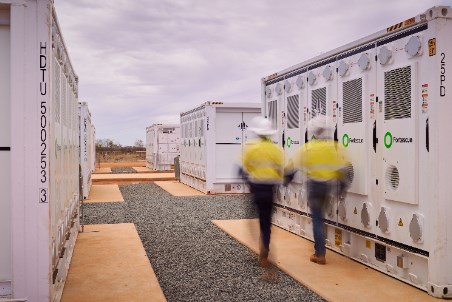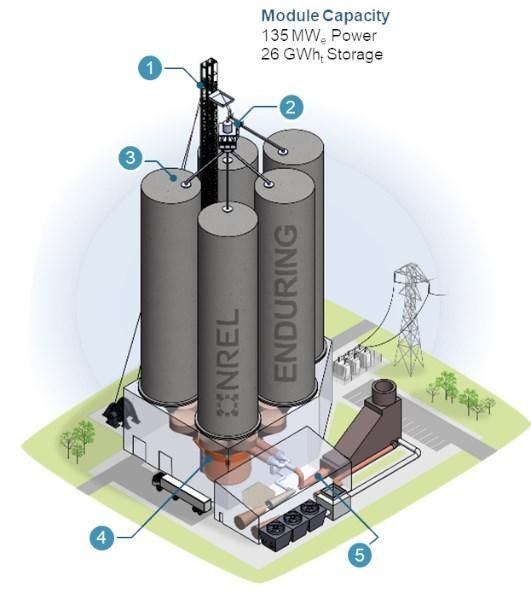Optimal maximum power point tracking strategy based on greater cane rat algorithm for wind energy conversion system – Nature

Executive Summary: Optimizing Wind Energy for Sustainable Development
In alignment with the United Nations Sustainable Development Goals (SDGs), particularly SDG 7 (Affordable and Clean Energy) and SDG 13 (Climate Action), maximizing the efficiency of renewable energy sources is a global priority. This report details an investigation into enhancing the power output of Wind Energy Conversion Systems (WECS) through an advanced Maximum Power Point Tracking (MPPT) strategy. The study introduces a novel, nature-inspired metaheuristic, the Greater Cane Rat Algorithm (GCRA), to optimize the performance of a WECS. The system, comprising a wind turbine, a Permanent Magnet Synchronous Generator (PMSG), and a DC/DC boost converter, was modeled and simulated in MATLAB/SIMULINK. The GCRA-based controller regulates the converter’s duty cycle to track the maximum power point without requiring mechanical sensors, contributing to SDG 9 (Industry, Innovation, and Infrastructure) by reducing system complexity and cost. Comparative analysis against conventional Perturb & Observe (P&O), Particle Swarm Optimization (PSO), and Gray Wolf Optimization (GWO) methods under various wind profiles demonstrates the superior performance of the proposed strategy. The GCRA approach achieved a tracking efficiency exceeding 99%, significantly outperforming the 95.5% (PSO), 94.7% (GWO), and 91.4% (P&O) efficiencies of other methods. These findings confirm that the GCRA strategy offers a robust and highly efficient solution for maximizing clean energy generation, representing a significant advancement in sustainable energy technology.
1.0 Introduction: The Role of Efficient Wind Energy in Achieving Global Goals
1.1 The Global Energy Context and Sustainable Development
The increasing global population and industrialization have led to a substantial rise in worldwide energy consumption. Historically, this demand has been met by fossil fuels, which are finite and contribute significantly to greenhouse gas emissions, exacerbating global warming and hindering progress toward SDG 13 (Climate Action). To address this, a global transition to Renewable Energy Sources (RESs) is imperative. This shift is central to achieving SDG 7 (Affordable and Clean Energy), which aims to ensure universal access to affordable, reliable, and modern energy services. Among RES technologies, wind energy is a leading candidate due to its clean, abundant, and carbon-free nature.
1.2 Challenges in Wind Energy Conversion
The primary challenge in harnessing wind power lies in its intermittent and unpredictable nature. To maximize energy capture from variable wind speeds, Wind Energy Conversion Systems (WECS) must continuously operate at their Maximum Power Point (MPP). This requires sophisticated MPPT control techniques. While various methods exist, they often face a trade-off between complexity, cost, accuracy, and convergence speed. Conventional techniques like Perturb & Observe (P&O) are simple but suffer from oscillations and imprecision, reducing overall energy yield and undermining the full potential of wind infrastructure. The development of more intelligent and efficient MPPT controllers is therefore critical to enhancing the viability and contribution of wind energy to global sustainability targets.
1.3 Report Objectives and Contributions
This report presents a novel MPPT controller for a standalone, sensor-less WECS based on the Greater Cane Rat Algorithm (GCRA), a recently developed meta-heuristic optimization technique. The primary objective is to improve the power tracking efficiency and robustness of the WECS, thereby maximizing its contribution to sustainable energy goals. The main contributions are:
- The first application of the GCRA to optimize power tracking in a PMSG-based WECS without mechanical sensors, promoting innovative and cost-effective sustainable infrastructure (SDG 9).
- A comprehensive performance evaluation of the GCRA-based controller under diverse and realistic wind conditions, demonstrating its superiority over established optimization algorithms.
- A quantifiable enhancement in clean energy generation, directly supporting the objectives of SDG 7 and SDG 13.
2.0 System Model and Methodology
2.1 The Wind Energy Conversion System (WECS) Model
The study is based on a standalone WECS designed to power a resistive load. The system architecture represents a common configuration for small- to medium-scale clean energy applications, crucial for decentralized power in line with SDG 11 (Sustainable Cities and Communities). The key components include:
- Wind Turbine: A fixed-pitch turbine that converts the kinetic energy of wind into mechanical power.
- Permanent Magnet Synchronous Generator (PMSG): A highly efficient, direct-drive generator that converts mechanical rotation into electrical power, favored for its reliability and low maintenance.
- Uncontrolled Rectifier: Converts the AC output of the PMSG to DC.
- DC/DC Boost Converter: Regulates the DC voltage to match the load requirements and is controlled by the MPPT algorithm to ensure maximum power transfer.
This sensor-less configuration tracks the MPP by analyzing electrical variables (voltage and current), eliminating the need for mechanical wind speed or rotor speed sensors. This design reduces implementation costs and enhances system reliability, making clean energy technology more accessible.
2.2 The Greater Cane Rat Algorithm (GCRA) for MPPT
The core of the proposed MPPT strategy is the GCRA, a metaheuristic algorithm inspired by the foraging and social behaviors of greater cane rats. The algorithm is designed to efficiently explore the search space to find the optimal duty cycle for the boost converter that corresponds to the MPP. The operational phases of the GCRA include:
- Initialization: A population of potential solutions (duty cycles) is randomly generated within predefined bounds.
- Exploration Phase: The algorithm simulates the rats’ search for new food sources, allowing for a broad exploration of the solution space to avoid local optima. This is crucial for adapting to significant changes in wind speed.
- Exploitation Phase: The algorithm models the behavior of rats converging on known, abundant food sources. This phase refines the search around the most promising solutions to quickly converge on the true MPP.
The GCRA’s balance between exploration and exploitation allows it to rapidly and accurately adapt to dynamic wind conditions, ensuring the WECS consistently operates at peak efficiency.
3.0 Results and Discussion: Performance Analysis
The proposed GCRA-based MPPT controller was evaluated against P&O, PSO, and GWO controllers under three distinct wind profiles: step variation, turbulent variation, and ramp variation. The performance was assessed based on tracking efficiency, response time, steady-state oscillation, and error indices.
3.1 Performance Under Step and Ramp Wind Variations
Under sudden (step) and gradual (ramp) changes in wind speed, the GCRA controller demonstrated superior performance.
- Tracking Efficiency: The GCRA achieved an average tracking efficiency of 99.1%, significantly higher than GWO (95.8%), PSO (95.5%), and P&O (91.2%). This translates directly to a greater yield of clean energy, reinforcing its contribution to SDG 7.
- Response Time: The GCRA converged to the new MPP in approximately 0.04 seconds, faster than all other methods. This rapid adaptation minimizes power loss during wind speed transitions.
- Stability: The GCRA exhibited negligible steady-state oscillations (less than 0.1%), ensuring stable power delivery and optimal utilization of the wind turbine. In contrast, the GWO method showed significant oscillations, leading to power loss and potential mechanical stress.
3.2 Performance Under Realistic Turbulent Wind Conditions
To simulate real-world conditions, the controllers were tested with a turbulent wind profile. The GCRA maintained its superior performance, accurately tracking the fluctuating MPP and maximizing energy capture.
- Average Efficiency: The GCRA achieved an average efficiency of 99.2%, followed by GWO (95.8%), PSO (94.1%), and P&O (89.6%).
- Robustness: The results confirm that the GCRA is highly robust and can effectively handle the random and complex nature of wind, making it a reliable technology for sustainable energy infrastructure (SDG 9).
- Error Analysis: The GCRA produced the lowest Integral Absolute Error (IAE) and Integral Time Square Error (ITSE) values, indicating the highest accuracy and precision in tracking the optimal power point.
4.0 Conclusion and Recommendations
4.1 Summary of Findings
This report successfully demonstrated the effectiveness of a novel MPPT strategy for WECS using the Greater Cane Rat Algorithm. The proposed GCRA-based controller significantly outperforms conventional and other metaheuristic-based methods in terms of tracking efficiency, response speed, and stability under diverse wind conditions. By achieving a tracking efficiency of over 99% without mechanical sensors, this approach enhances both the energy yield and economic viability of wind power systems.
4.2 Implications for Sustainable Development Goals
The outcomes of this research provide a direct and significant contribution to several SDGs:
- SDG 7 (Affordable and Clean Energy): By maximizing the power extracted from wind, the GCRA makes wind energy a more efficient and reliable source, contributing to the goal of increasing the share of renewables in the global energy mix.
- SDG 13 (Climate Action): Enhanced WECS efficiency accelerates the displacement of fossil fuel-based power generation, directly supporting efforts to combat climate change.
- SDG 9 (Industry, Innovation, and Infrastructure): The development of a low-cost, sensorless, and highly intelligent control system represents a key innovation in building resilient and sustainable energy infrastructure.
4.3 Recommendations for Future Work
While the simulation results are promising, further research is recommended to validate and expand upon these findings. Future work should focus on:
- Experimental Validation: Implementing the GCRA controller on a hardware prototype to verify its performance in a real-world physical system.
- Grid-Connected Systems: Evaluating the performance of the GCRA-based MPPT in on-grid WECS applications.
- Hybrid Systems: Exploring the application of the GCRA to optimize the performance of hybrid renewable energy systems (e.g., wind-solar).
Continued innovation in this field is essential for advancing renewable energy technology and achieving a sustainable energy future for all.
Analysis of Sustainable Development Goals in the Article
1. Which SDGs are addressed or connected to the issues highlighted in the article?
-
SDG 7: Affordable and Clean Energy
The article is fundamentally centered on improving the efficiency of wind energy, a key renewable source. It directly addresses the need for clean energy by focusing on “maximizing the power produced from wind energy conversion system (WECS).” The introduction highlights the shift from “traditional fossil fuel-based power generation” to “renewable sources of energy (RESs)” like wind, which it describes as a “clean, infinite energy source with approximately no emission of carbon.” This aligns perfectly with the goal of ensuring access to affordable, reliable, sustainable, and modern energy for all.
-
SDG 13: Climate Action
The article explicitly links the use of traditional energy sources to negative environmental impacts, stating that “the usage of these sources raises level of carbon dioxide emission and contributes to significant anxieties on surrounding environment for instance the current global warming.” By developing a technology that enhances the performance of wind energy systems, the research contributes directly to climate change mitigation efforts, which is the core of SDG 13.
-
SDG 9: Industry, Innovation, and Infrastructure
The research embodies innovation by proposing a “recently developed nature-inspired metaheuristic, termed the Greater Cane Rat Algorithm (GCRA)” to solve a technical challenge in the renewable energy industry. This work contributes to building resilient infrastructure and fostering innovation by creating more efficient and robust energy systems. It is a clear example of enhancing scientific research and upgrading technological capabilities in the clean energy sector.
-
SDG 11: Sustainable Cities and Communities
The article’s introduction references the need for “green energy for smart cities.” By improving the efficiency and reliability of renewable energy sources like wind power, the technology discussed can help make cities more sustainable. Clean energy is a critical component for reducing the environmental footprint of urban areas and creating healthier living environments.
2. What specific targets under those SDGs can be identified based on the article’s content?
-
Target 7.2: Increase substantially the share of renewable energy in the global energy mix.
The entire study is aimed at making wind energy more efficient and productive. By developing an algorithm that achieves a tracking efficiency “that exceeds 99%,” the research makes wind power a more reliable and economically viable contributor to the energy mix, thereby supporting an increase in its overall share.
-
Target 9.4: Upgrade infrastructure and retrofit industries to make them sustainable, with increased resource-use efficiency and greater adoption of clean and environmentally sound technologies.
The proposed GCRA is a “novel MPPT controller technique” that represents a technological upgrade for wind energy infrastructure. Its purpose is to increase the efficiency of converting wind into electrical power, which is a direct improvement in resource-use efficiency for a clean technology.
-
Target 9.5: Enhance scientific research, upgrade the technological capabilities of industrial sectors…encouraging innovation.
This article is a direct output of scientific research. It introduces a “first-of-its-kind application of a recently-published nature-inspired metaheuristic optimization technique” to the field of wind energy. This enhances technological capabilities and represents the kind of innovation needed to advance the renewable energy sector.
-
Target 13.2: Integrate climate change measures into national policies, strategies and planning.
While the article is technical, it provides a technological solution that enables the implementation of climate change strategies. The motivation for the research is to overcome the limitations of fossil fuels, which cause “global warming.” Efficient renewable energy technologies are essential tools for any policy aimed at reducing carbon emissions.
3. Are there any indicators mentioned or implied in the article that can be used to measure progress towards the identified targets?
Yes, the article provides several quantitative and qualitative indicators to measure the performance of the new technology, which in turn can be used to measure progress towards the SDG targets.
-
Tracking Efficiency (%):
This is the primary indicator used in the article. It directly measures how effectively the system converts available wind energy into electrical power. The article states the proposed GCRA approach achieves an efficiency “that exceeds 99%,” compared to lower efficiencies of 95.5%, 94.7%, and 91.4% for other methods. This is a direct measure of progress for Target 7.2.
-
Power Coefficient (Cp):
This indicator measures the turbine’s efficiency in converting wind power into mechanical power. The article notes that the GCRA method helps achieve the “maximum value of Cp equals 0.48,” which is the theoretical optimum. This indicates maximum resource-use efficiency, relevant to Target 9.4.
-
Error Indices (IAE and ITSE):
The article uses the Integral Absolute Error (IAE) and Integral Time Square Error (ITSE) to quantify the precision of the control system. The proposed GCRA method had the “least values of indices by about 1 for both IAE and ITSE,” demonstrating its superior performance and technological advancement, which relates to Target 9.5.
-
Reduction in Carbon Emissions:
This is an implied indicator. The introduction contrasts clean wind energy (“approximately no emission of carbon”) with fossil fuels that raise “level of carbon dioxide emission.” By improving wind energy efficiency, the technology facilitates a greater displacement of fossil fuels, thus leading to a reduction in emissions, which is a key measure for Target 13.2.
-
Oscillation Ratio and Response Time:
These indicators measure the stability and speed of the control system. The article highlights that the GCRA method has the “lowest oscillation ratio throughout the entire simulation period, never exceeding 0.1%” and the “shortest response time.” These metrics demonstrate the robustness and reliability of the innovative technology, relevant to Targets 9.4 and 9.5.
4. Summary Table of SDGs, Targets, and Indicators
| SDGs | Targets | Indicators |
|---|---|---|
| SDG 7: Affordable and Clean Energy | 7.2: By 2030, increase substantially the share of renewable energy in the global energy mix. |
|
| SDG 9: Industry, Innovation, and Infrastructure |
9.4: Upgrade infrastructure and retrofit industries to make them sustainable, with increased resource-use efficiency and greater adoption of clean and environmentally sound technologies.
9.5: Enhance scientific research, upgrade the technological capabilities of industrial sectors…encouraging innovation. |
|
| SDG 13: Climate Action | 13.2: Integrate climate change measures into national policies, strategies and planning. |
|
Source: nature.com

What is Your Reaction?
 Like
0
Like
0
 Dislike
0
Dislike
0
 Love
0
Love
0
 Funny
0
Funny
0
 Angry
0
Angry
0
 Sad
0
Sad
0
 Wow
0
Wow
0



















































.jpg.webp?itok=0ZsAnae9#)

























